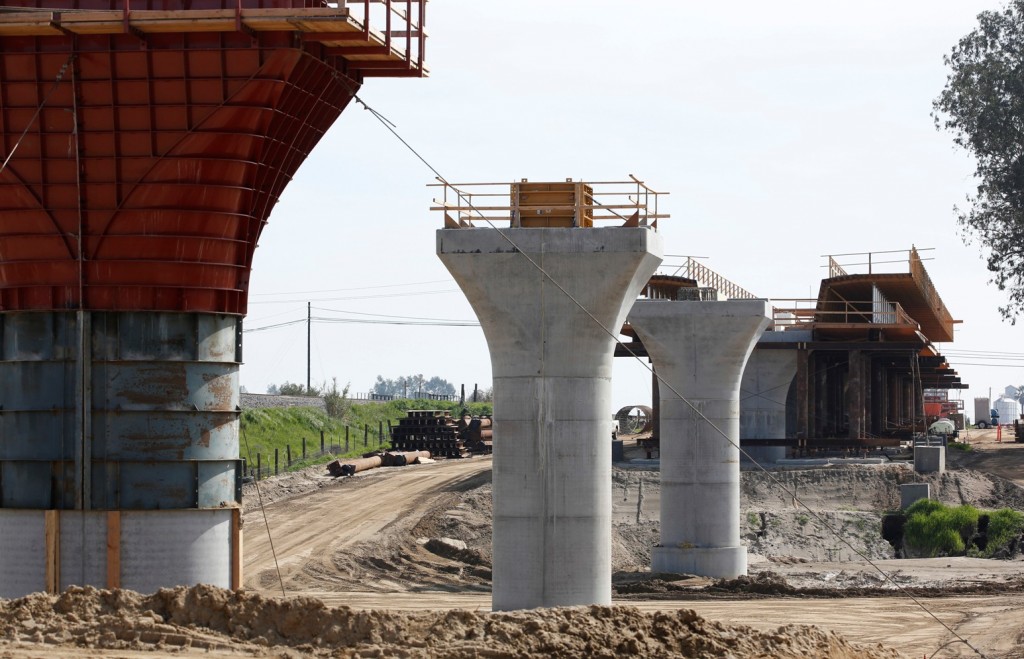- California Assembly OKs highest minimum wage in nation
- S. Korea unveils first graphic cigarette warnings
- US joins with South Korea, Japan in bid to deter North Korea
- LPGA golfer Chun In-gee finally back in action
- S. Korea won’t be top seed in final World Cup qualification round
- US men’s soccer misses 2nd straight Olympics
- US back on track in qualifying with 4-0 win over Guatemala
- High-intensity workout injuries spawn cottage industry
- CDC expands range of Zika mosquitoes into parts of Northeast
- Who knew? ‘The Walking Dead’ is helping families connect
Planning for California bullet train allowed to move forward

In this Friday, Feb. 26, 2016, photo, the supports for a 1,600-foot-viaduct to carry high-speed rail trains across the Fresno River are seen under construction near Madera, Calif. Sacramento County Superior Court Judge Michael Kenny ruled against plaintiffs in a lawsuit to stop construction of the project, ruling Tuesday, March 8, 2016 that planning and financing of the $64 billion bullet train can proceed. (AP Photo/Rich Pedroncelli)
SACRAMENTO, Calif. (AP) — A judge has removed a major hurdle to California’s high-speed rail system, ruling that the $64 billion system does not violate promises made to the voters who approved it and that planning and financing can proceed.
The ruling announced Tuesday came in a lawsuit filed by attorneys for Kings County and a group of landowners who claim the state’s projections on ridership, construction and operating figures are not reliable.
They asked the judge to block the state from spending money on the project.
However, Sacramento County Superior Court Judge Michael Kenny said the 2008 ballot initiative specified only that the state could issue bonds to construct a high-speed rail system and did not prevent modifications to the plan voters were given.
He agreed with the plaintiffs that the California High-Speed Rail Authority has not proven the rail system will be financially viable or can meet the travel times voters were promised but said the system continues to evolve so it is premature for the court to intervene.
“The authority may be able to accomplish these objectives at some point in the future. This project is an ongoing, dynamic, changing project,” Kenny wrote.
Voters have approved $10 billion in bonds for what would be the nation’s first high-speed rail line, and California has secured another $3.2 billion in federal matching funds. In addition, the project will receive money each year from the state’s greenhouse gas emission fund. The amount will total $500 million this year.
That funding leaves it far short of its $64 billion price tag, and state lawmakers and the Republican-controlled Congress have balked at providing more money.
Still, backers believe segments of the project can be operating within the next decade.
Dan Richard, chairman of the board that oversees the rail authority, expressed relief at the judge’s ruling. He said “a great myth” has developed that the system being built is different than the one voters approved.
“It’s totally and completely false,” Richard said at a board meeting Tuesday. “What we are building is exactly what the public voted for: a fully electric, 200-plus mile-per-hour train that can operate without a subsidy that is designed to operate in 2 hours and 40 minutes between our great cities of Los Angeles and San Francisco.”
Plaintiffs argued that plans for the bullet train have strayed far from the promises made to voters, particularly on trip times, ridership and maintenance costs.
Plaintiffs’ attorney Stuart Flashman said his clients would be evaluating their next steps.
“Though the high-speed rail authority may have won this round, the ruling … provides ominous signs about the authority’s future use of bond funds,” Flashman said in an email.
Voters were told the trains would whisk travelers from San Francisco to Los Angeles in 2 hours and 40 minutes, and the system would operate without a government subsidy. Opponents say neither is possible under current plans.
It was also pitched as a stand-alone system that would not have to share tracks with slower commuter rail lines.
Since then, plans have changed repeatedly as state officials made political compromises, including the decision to share tracks with commuter trains in some sections.
Gov. Jerry Brown’s administration lowered the cost estimate to $64 billion in February as part of a new proposed business plan that upended plans for the rail line.
The change, which still requires board approval, would send tracks from the Central Valley north to the San Francisco Bay Area instead of south as planned since 2012.
It also calls for a 250-mile segment from San Jose to north of Bakersfield to begin operating by 2025.













![배우 김민희와 홍상수 감독[스타뉴스]](http://www.koreatimesus.com/wp-content/uploads/2025/04/20250408101705671-120x134.jpg)

